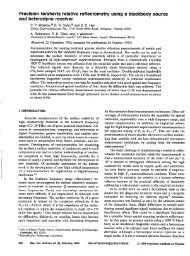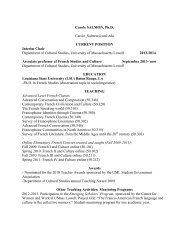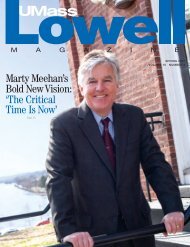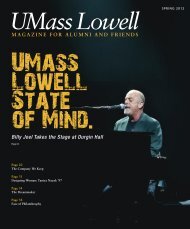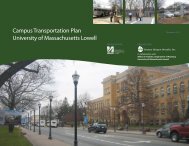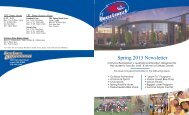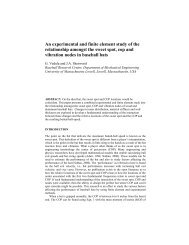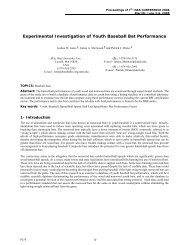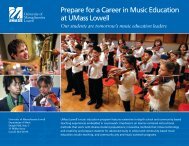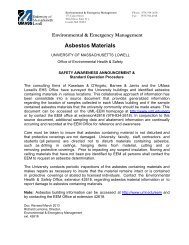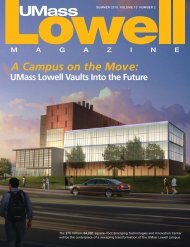Summer 2011 - University of Massachusetts Lowell
Summer 2011 - University of Massachusetts Lowell
Summer 2011 - University of Massachusetts Lowell
Create successful ePaper yourself
Turn your PDF publications into a flip-book with our unique Google optimized e-Paper software.
Ourworld<br />
MONSTER QUAKES: ARE WE AT RISK?<br />
The magnitude 9.0 earthquake that rocked the northeastern coast <strong>of</strong> Japan on March<br />
11 unleashed deadly tsunami waves that wiped out entire villages. What are the<br />
chances <strong>of</strong> such a devastating earthquake happening right here in New England?<br />
“Nobody knows for sure,” says Pr<strong>of</strong>. Arnold O’Brien <strong>of</strong> the Environmental, Earth<br />
and Atmospheric Sciences Department. “Unlike on the West Coast, earthquakes<br />
happen so infrequently here in the Northeast that they are more difficult to predict.<br />
Our historical records date back only to the 1600s and they are very sketchy.”<br />
According to the U.S. Geological Survey, the last time New England experienced a<br />
series <strong>of</strong> major seismic events was in the 1700s. The region’s most powerful temblor to<br />
date took place on Nov. 18, 1755, in the Cape Ann region east <strong>of</strong> Newbury. In Boston,<br />
chimneys were leveled or heavily damaged,<br />
and stone fences were knocked down. New<br />
springs formed, and old springs dried up.<br />
Ground cracks were reported in Scituate,<br />
Pembroke and Lancaster, and the shaking<br />
was felt from Halifax, Nova Scotia, to<br />
Chesapeake Bay in Maryland.<br />
Today there is a fault zone — called the<br />
Clinton–Newbury Fault — that runs about<br />
a mile south <strong>of</strong> UMass <strong>Lowell</strong>’s North Campus<br />
close to Route 110 in <strong>Lowell</strong>, and continues<br />
through Drum Hill and Westford,<br />
O’Brien says. It’s an ancient “suture” that<br />
was created during the Paleozoic era about<br />
250 million to 450 million years ago, he<br />
says, when an island mass collided with the<br />
North American tectonic plate and was<br />
dragged underneath it.<br />
Compared to the San Andreas Fault in<br />
western North America, which is the most<br />
heavily studied and monitored fault on the<br />
continent and where ground movement is<br />
High-rise buildings in downtown<br />
Boston are at great risk <strong>of</strong><br />
structural damage in the event<br />
<strong>of</strong> a severe earthquake.<br />
UNIVERSITY NUCLEAR ENERGY<br />
EXPERT IN DEMAND<br />
C A M P U S N E W S<br />
so evident, the Clinton–Newbury Fault is not very well<br />
investigated. However, O’Brien says there has not been<br />
any significant seismic activity in the Clinton–Newbury<br />
Fault and he doesn’t expect any in the foreseeable future.<br />
That’s a good thing – because according to civil engineering<br />
Asst. Pr<strong>of</strong>. Tzu-Yang Yu, “Here in New England,<br />
new buildings need only to meet the minimum level<br />
<strong>of</strong> seismic resistance in their design. This is based largely<br />
on the site’s characteristics and the seismic history <strong>of</strong> the<br />
region.”<br />
A severe earthquake here would create “unimaginable”<br />
devastation, Yu says: “Buildings 10 stories or higher that<br />
were built to the current standard would be subject to<br />
considerable structural damage. Walls would crack and<br />
the buildings would sink or tilt, though not necessarily<br />
collapse.”<br />
As reporters, elected <strong>of</strong>ficials and pundits scrambled to<br />
understand what was happening at the damaged nuclearpower<br />
plants in Japan, many <strong>of</strong> them turned to UMass<br />
<strong>Lowell</strong>’s Gil Brown. The nuclear engineering pr<strong>of</strong>essor<br />
was interviewed by media outlets from across the country,<br />
including Time magazine and the Washington Post.<br />
“We need to demystify<br />
the nuclear power process<br />
and be cautious” about making<br />
sweeping statements, says<br />
Brown. “The situation is a<br />
moving target – it’s the middle<br />
<strong>of</strong> the storm – and too<br />
soon to draw conclusions<br />
about lessons learned.”<br />
He points out, however,<br />
that the Japanese plants<br />
survived an earthquake far<br />
Gil Brown<br />
beyond their designed limits. The reactors shut down<br />
power production exactly as they should, bringing the<br />
core temperatures down dramatically. But the tsunami<br />
waves overtopped the 20-foot seawall, damaging the<br />
emergency generator system that would be used to<br />
circulate cooling water over the still-hot fuel rods.<br />
“The Japanese are doing what they can to contain<br />
the radioactivity, using the emergency procedures that<br />
are known and rehearsed,” says Brown. Calling the technique<br />
“bleed and feed,” he draws the analogy <strong>of</strong> a tea<br />
kettle on a heat source: As heat builds up, steam can be<br />
vented <strong>of</strong>f at the top, so that more water can be added.<br />
Pointing out that every U.S. plant is likely now<br />
checking its own design tolerances, emergency procedures<br />
and ability to operate under blackout conditions,<br />
Brown says, “It’s time to review and reflect, not time to<br />
panic. Plants that were safe last week are safe this week.”<br />
S U M M E R 2 0 1 1 UMASS LOWELL MAGAZINE 3



